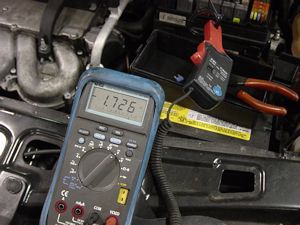A Tale of Two Circuits
A Tale of Two Circuits
Diagnosing an electrical problem with an A/C compressor, blower or cooling fan? The first step is to figure out which of two circuits you need to focus on.

You can quickly determine which of the two circuits needs your attention using a low amp current probe and your meter.
Motor Age — The automotive A/C system has several high current components that the electronic control units (ECU) manages, including the A/C compressor coil, blower motor and fan motors. Current flow through these components can run from three amps or so, to better than 20 amps. Current flow of that kind would spell almost certain death if it passed directly through the driver of a typical ECU, so a neat little electrical device known as the relay acts as an intermediary.
The current required to turn a relay on or off usually is no more than a few tenths of an amp, a level the controller can handle. While the use of relays to control high current devices is certainly not limited to the A/C system (fuel pumps and window motors jump to mind), because this is our A/C issue, we’ll focus on those applications.
One Fault, Two Circuits?
If you remember your electrical fundamentals, you know that every circuit has five basic elements: a source (typically the battery), a load (the component that the circuit is designed to operate), a circuit protection device (a fuse, circuit breaker or fusible link), a control (a means to open or close the electrical pathway and turn the load on or off) and a complete path that connects all of them together. When a load doesn’t work the way it’s supposed to, the fault has to lie in one of these five areas. Easy, right?
How does all this apply to a relay-controlled circuit? The relay is an electrically operated switch that closes and opens the current path to the primary component (the compressor coil, blower or fan motor) we’re trying to operate, doesn’t it? That makes it a control in the primary component’s circuit.
But it is electrically controlled. Something else is turning the relay on (the electronic control unit that is managing the primary component). Doesn’t that make the relay a load, too? That’s another circuit entirely.
The first step in diagnosing a problem in a relay-controlled circuit is to figure out whether the problem is on the primary component side of the relay or the load side of the relay. Most of us understand this instinctively when we glance over the schematic. The relay marks an electrical crossroads of sorts. I know I’m not the only one who has stolen a relay from another section of the fuse box and swapped it with the suspect relay. If the primary component now works, though, does that mean it was the relay’s fault? And what did we learn if the component the relay is supposed to control still doesn’t work?
Source: Motor Age

